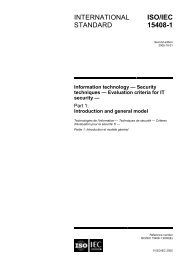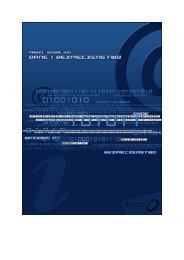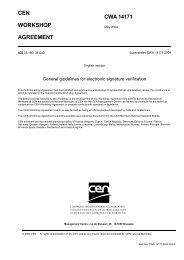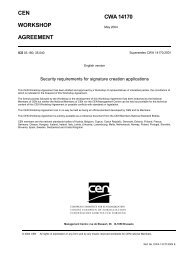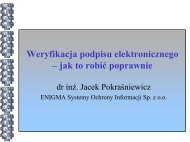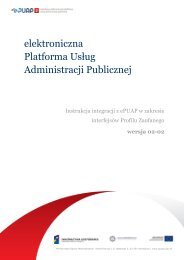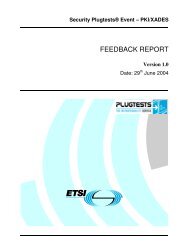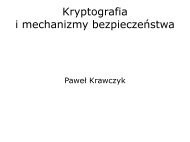When electronic signature becomes a information services ... - IPSec
When electronic signature becomes a information services ... - IPSec
When electronic signature becomes a information services ... - IPSec
Create successful ePaper yourself
Turn your PDF publications into a flip-book with our unique Google optimized e-Paper software.
QES). 11 This is a perfect example on how ignoring the human factor in the design of the system<br />
rendered a perfectly secure architecture (at least theoretically 12 ) unusable. Potential users<br />
declined to consider using the QES, and used WinZip if they wanted a generic file archive, and<br />
possibly SecureZIP, if they wanted enhanced security features. In addition, if a user wanted to<br />
produce an <strong>electronic</strong> document with an embedded <strong>signature</strong>, then they would rather consider<br />
the digital <strong>signature</strong> features in MS Office, Open Office or Adobe Acrobat, although these are<br />
not suitable for a QES, for the reasons explained below. 13<br />
Parallel worlds, parallel applications<br />
A great deal of paper was used and words expended on the meaning of the important sentence<br />
dealing with ‘sole control’ of the signatory in Directive 1999/93/EC. 14 The main consequence<br />
of these disputes was a set of very strict technical requirements for <strong>signature</strong> creation devices<br />
and applications that were subsequently refined in a series of CEN Workshop Agreement<br />
(CWA) and European Telecommunications Standards Institute (ETSI) technical standards.<br />
These requirements effectively prevented the use of such applications as MS Office, Open<br />
Office or Adobe that supported digital <strong>signature</strong>s, conveniently embedded in their <strong>electronic</strong><br />
document formats, but not in the way required by the CWA or ETSI. 15 In addition, since the<br />
11<br />
Editors note: most lawyers across the globe still do not understand the basic elements of <strong>electronic</strong> <strong>signature</strong>s yet.<br />
12<br />
According to the Polish technical regulation of the QES (Rozporządzenie Rady Ministrów z dnia 7 sierpnia 2002 r. w sprawie<br />
określenia warunków technicznych i organizacyjnych dla kwalifikowanych podmiotów świadczących usługi certyfikacyjne, polityk certyfikacji<br />
dla kwalifikowanych certyfikatów wydawanych przez te podmioty oraz warunków technicznych dla bezpiecznych urządzeń służących do<br />
składania i weryfikacji podpisu elektronicznego (Dz. U. z dnia 12 sierpnia 2002 r.) a ‘public’ <strong>signature</strong> creation software requires a ‘trusted<br />
channel’ (paragraph 4.4). That is, a security feature that can prevent the modification of data in transit as it is read from file and sent to the<br />
technical component (smart card) for <strong>signature</strong> (this was the basis of the G DATA attack in 2005). Unfortunately the ‘public software’<br />
(paragraph 2.9) is defined in such way that it excludes virtually any software used at home or in the office (and nothing else is left). From a<br />
business point of view, the objective of this requirement is obvious – no general-purpose operating system (such as Windows or Linux or<br />
MacOS) can offer such a feature in the strict sense, so having it in force would prevent anyone from using QES on these systems. From an<br />
engineering point of view, however, this is a clear sign that the regulators had no idea what they were going to use the technology for and what<br />
they are trying to protect from.<br />
13<br />
Note the discussion on this topic by Nicholas Bohm, ‘Watch what you sign!’, Digital Evidence and Electronic Signature Law<br />
Journal, 3 (2006) 45 – 49.<br />
14<br />
Directive 1999/93/EC, Article 2, item 2c requires that an ‘advanced <strong>electronic</strong> <strong>signature</strong>’ is ‘created using means that the signatory<br />
can maintain under his sole control’. The technical interpretation of this phrase was discussed in CWA (14355, 14365), ETSI TS (102 042) and<br />
FESA (Forum of European Supervisory Authorities for Electronic Signatures) statements (2004, 2005). For an exposition on this point in legal<br />
terms, see Stephen Mason, Electronic Signatures in Law (2nd edn, Tottel, 2007) 4.6 and 4.9.<br />
15<br />
More precisely, this was the case for those jurisdictions that required a qualified <strong>electronic</strong> <strong>signature</strong> with a qualified certificate and<br />
a secure <strong>signature</strong> creations device (SSCD in CWA 14169 terms) and where <strong>signature</strong> creation application (SCA) was regulated (a declaration<br />
of compliance, as required by the Polish <strong>electronic</strong> <strong>signature</strong> act from 2001). In Poland, the SSCD itself was defined as hardware (a smart card)<br />
plus software. The problem with this approach was that while it may be considered by some that the security inherent in a smart card is<br />
substantial (until it is lost or stolen), the added value of an SCA is much smaller. At the same time, the administrative and legal burden has<br />
increased significantly, because new, QES compliant programs must be created and the user cannot use those they previously used on daily<br />
basis any more.



